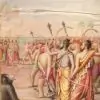Deep down South of the Vindhyas, on the banks of the fertile Cavery, lies the most important kshetra for Tamil Vaishnavites- Srirangam- and in it -the temple of Rangannatha Swamy (a form of Vishnu).
Srirangam can be considered the biggest functioning Hindu temple in the world as it covers an area of about 6,31,000 m. (156 Acres) with a perimeter of 4 km (10,710 ft)Srirangam claims to be the biggest functioning temple, because Angkor Wat is the biggest but non-functioning Hindu temple in the world.The
gopuram of the temple is called the Rajagopuram and is 236 feet (72 m) tall, the tallest in Asia. Myth has it that the coast of Sri Lanka can be seen from the top of the gopuramSo what does all this have to do with Ramayana?
The answer lies in the history of the idol
Legend has it that once Brahma was engaged in tapas for a very long time. A glittering Vimana sprang as a result of the tapas in the depths of the Milky ocean. It was borne by the celestial bird Garuda. Adisesha, had spread his hood over it. Vishvaksena, the Archangel-in-chief walked in front clearing the way. The Sun and Moon were fanning the Deity. The celestial Musicians Narada and Thumburu followed singing His Glory. Rudra and other gods raised the "jayaghosha". The celestial maids danced. There was a rain of flowers.
Awakened from his deep tapas, Brahma prostrated before the Vimana. He recited the four vedas and gazed in wonderment. Sunanda, a celestial guard informed him that the Lord was pleased with his penance and had come in answer to his prayers. When Brahma looked into the Vimana, he found there the Supreme Lord resting with his Consorts. The Lord informed Brahma that he had come as a Svayamvyakta -- on his own volition -- as an idol. He would appear likewise in eight places on earth -- Srirangam, Srimushnam, Venkatadri, Saligram, Naimisaranya, Totadri, Pushkara and Badri. Ranga Vimana is the first and the earliest of all these. The Lord directed Brahma to worship him strictly according to the procedure for worship laid down in the Agamas and lay down in his characteristic posture, in Yoganidra.
Brahma carried it to Satyaloka and installed it on the banks of the river, Viraja. He appointed the Sun god to do the daily pooja. After him, Vaivasvata Manu, performed the worship. When his son Ikshvaku, became the King of Ayodhya, he wanted to have it installed at Ayodhya. He entered on a tapas which lasted for many hundred years at the end of which he was permitted by Brahma to take it to Ayodhya.
Thus, the Vimana came to Ayodhya. After Ikshvaku, his descendants continued the service. Rama, himself an avatara of the Lord worshipped him and thereafter the Lord came to be known as "Periya Perumal". On his triumphant return from Sri Lanka, in the coronation held in grand style, Rama gave the Vimana as gift to Vibheeshana for worship.
Vibhishana asked to take the Ranga vimana and the idol to Srilanka. Rama agreed but instructed that it should not be placed anywhere on the ground till he had reached his destined place. But en-route to Srilanka, Vibhishana was overcome by an urgent urge to attend nature's call. Since he could not place it anywhere on the ground, he looked around and found a brahmin boy. Instructing the boy to hold the idol in his hands, Vibhishana left to have bath in a lake called Chandrapuskarani. He returned after taking his bath only to find that the boy had knowingly/unkowingly placed the idol on the ground. When he tried to lift the Vimana, it would not move. It had got stuck up. Vibheeshana was overcome with grief and shed tears. The Lord appeared before him and consoled him saying that he need not grieve as He had already decided to make the place His abode. He could come and worship him daily. It is said that Vibheeshana worships the Lord daily at midnight.
A chola king by name Dharma Varma who was then ruling the territory, had seen the Ranga Vimana at the Yagasala when Dasaratha performed the Putrakameshti Yaga. He was so fascinated that he wanted to have it installed in his region. When he undertook a tapas on the banks of Chandrapushkarani, the sages told him that Sri Ranga Vimana was expected to arrive any time and requested him to give up the penance.
Soon the "Sriranga Vimana" carried by Vibheeshana had arrived and the episode (explained above) had taken place. Dharma Varma was overjoyed as the Lord had willed to make it his abode. He built a shrine for the Vimana, the surrounding Prakara known as "Dharma Varma Veedhi" and arranged for proper daily worship.
In course of time, Nature devoured the site. The Sri Ranga Vimana and the structures disappeared and became a habitat for wild animals. A ruling prince of the Chola dynasty hunting to that spot overheard a parrot repeating a sloka.
Kaveree Viraja Seyam Vaikuntam Rangamandiram
Sa Vasudevo Pangeshah Pratyaksham Paramam Padam |
Vimanam Pranavakaram Vedasrungam Mahadhbhutham
Srirangasayee Bhagavan Pranavarthaprakasakah ||
The river Kaveri is the very same river Viraja that eternally flows in Vaikunta, Srirangam Temple is verily Vaikuntam itself, the Abode of Lord Vishnu where he sits in all splendour and majesty in the company of Nityasuris.
The Lord of Arangam, is none but Vasudeva, the Primeval Lord Himself. The Vimana is verily the external Paramapada itself.
The Vimana is in the form of the Pranava (the life sustaining mantra). The four towers are marvelously akin to the four Vedas and the Lord, Sri Rangasayee is expounding the import of the Pranava.
On understanding the import of this sloka, the chola caused the earth towards the west of the tree (known as Tirumudikkurai) to be dug deep to lay a secure foundation for the Sriranga Vimana. But the Lord appeared before him in a dream and pointed out to him the exact spot wherein he lay. The king was overjoyed at finding the glittering Ranga Vimanam there. He cleared the forest, constructed all the essential parts of the temple, laid down flower gardens, instituted temple services and forms of worship.
This is the history of the temple at Srirangam. For orthodox Vaishnavites, there is no greater kshetra for Perumal than Srirangam, other than Tirupati. It is believed that Narayana prefers to reside here than in Vaikunth. That is why it is called 'Bhuloka Vaikuntham'

























